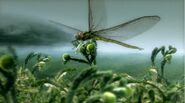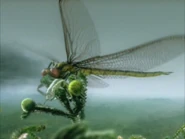Meganeura was an eagle-sized dragonfly that lived during the Late Carboniferous period to the Early Permian period.[2]
Creature attributes[]
Physical appearance and biology[]
Meganeura might have been the largest flying insect ever to exist[2] with its wingspan of up to 2[3]-2.5 ft.[2] The larva were also considerably large likely being asmuch as 12 inches in length.[2] Despite its large size Meganerua's biology was identifcal to modern day dragonflies except for having reproducive organs located in its tail rather than its head. It is believed that the reason for the organs location was to prevent the males from being eaten after mating like other dragonflies by putting the female in a trance-like state before proceeding to mate with her then flying away before the female has a chance to kill the male.[2]
Behaviour and traits[]
Meganerua spend the majority of its life in the air, only landing to mate, lay eggs,[2] seek shelter from storms, and sometimes to eat its prey.[1] Larva lived in vertical burrows in areas that were water. In this stage of life they were ambush predators, hunting spiders, insects, and small amphibians.[2] As adults, the prey of Meganeura was other dragonflies, mayflies, and terrestrial prey,[2] such as the early reptile Petrolacosaurus.[1] The only known predators of Meganerua were giant amphibians like Proterogyrinus.[1]
In Walking with Monsters[]
Reptile's Beginnings[]
A Meganerua stole a dead Petrolacosaurus off of a Mesothelae to eat it in a conifer. When a storm and forest fire happened during the night, a group of Meganeura flew around a lake in confusion. The Proterogyrinus in the lake kept trying to eat them in succession, but most of the insects got away.
Gallery[]
Behind the scenes[]
Meganeura did not live in the Early Permian, however, some of its relatives, such as Meganeuropsis did.
List of apperances[]
- Walking with Dinosaurs: A Natural History
- New Blood (Mentioned only)
- Walking with Monsters
- The Complete Guide to Prehistoric Life



